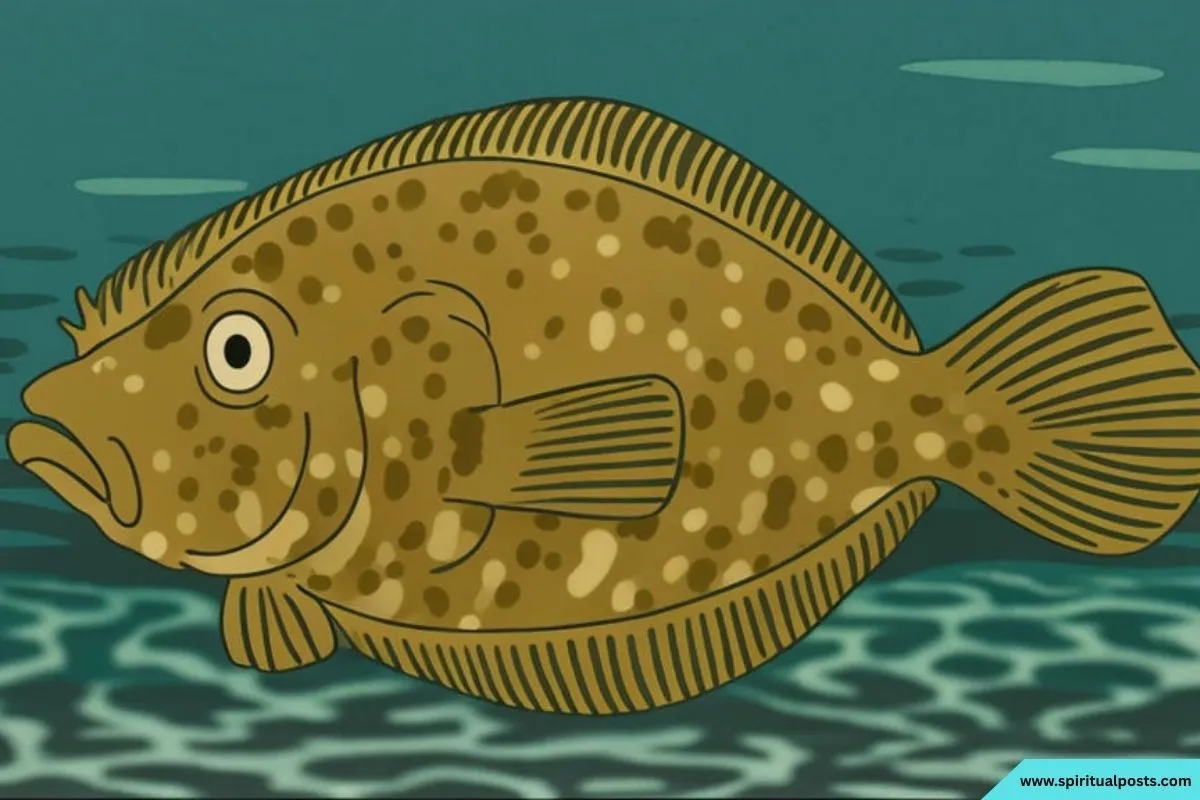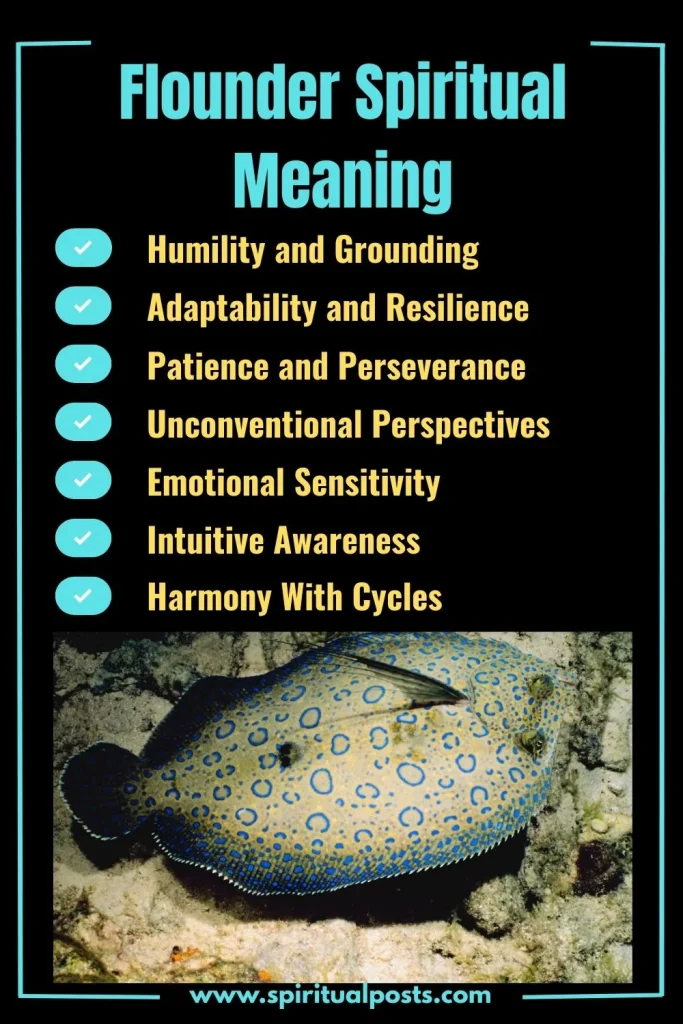Flounder Spiritual Meanings and Symbolism

Have you ever thought about what the flounder represents beyond its unusual appearance? This flatfish carries deep symbolic meanings, teaching us about adaptability, patience, and balance. Its way of life mirrors the challenges and changes we face, making it a powerful symbol for personal growth.

Key Takeaways
- Flounder symbolizes adaptability, flexibility, and the power to overcome adversity through its unique physical traits and camouflage abilities.
- The flounder’s humble and grounded nature represents the spiritual principles of humility, patience, and steadfast perseverance.
- In various cultural traditions, the flounder is associated with symbols of duality, balance, and the interconnectedness of life.
- Flounder imagery in art, literature, and mythology often explores themes of transformation, spiritual rebirth, and the complexities of human existence.
Introduction to Flounder
The flounder is a flatfish that lives on the ocean floor, blending into sand or mud to hide from predators. Its most striking feature is having both eyes on one side of its head, which helps it stay camouflaged while hunting. This clever design lets it wait motionless for prey to swim by.
Flounders live in oceans worldwide, from shallow coasts to deeper waters. They can grow from just a few inches to over two feet long, depending on the species. As both hunters and prey, they play a key role in marine ecosystems, keeping the balance of ocean life in check.
What Does It Mean When You See a Flounder?
Spotting a flounder can carry spiritual messages about how you handle change. Since flounders change color to match their surroundings, they symbolize adaptability and blending in. If you see one, it might mean you need to adjust to a new situation with flexibility.
Their habit of lying still on the ocean floor also represents patience and stillness. A flounder sighting could remind you to slow down, trust the process, and wait for the right moment to act. Sometimes, staying calm and observant leads to the best opportunities.
Flounder Symbolism in Life
Flounders teach us about resilience and staying grounded. As bottom-dwellers, they symbolize staying connected to your roots while navigating life’s changes. Their ability to adapt quickly reminds us that being flexible helps us survive challenges.
Their camouflage skills also represent the idea of blending in when needed, without losing your true self. The flounder’s quiet, patient hunting style encourages us to persist without rushing—success often comes to those who wait wisely.
By reflecting on the flounder’s traits, we can learn to move through life with balance, awareness, and steady determination. Its lessons remind us that sometimes, the best way forward is to adapt, stay patient, and trust in timing.
7 Spiritual Meanings of Flounder
As you learn about the flounder, you’ll see how this unique fish carries deep spiritual meanings. It connects strongly with humility, adaptability, and emotional awareness. These qualities can help guide your thoughts and behaviors in simple but powerful ways.
The flounder also teaches lessons about patience, intuition, and the value of seeing things from different perspectives. While it may look quiet and still, there’s so much happening beneath the surface.
Let’s explore each of these spiritual meanings in detail. Each one shows how this interesting fish can reflect parts of our own personal growth and inner journey.
1. Humility and Grounding
The flounder spends most of its life close to the ocean floor. This behavior reflects the quality of staying grounded, both physically and spiritually. It reminds you to stay close to your true self and not get caught up in pride or ego.
Being humble doesn’t mean being weak. It means knowing who you are and not needing to show off. The flounder teaches you to stay centered, even when life gets hard or uncertain.
By staying low to the ground, the flounder doesn’t draw too much attention. This helps it survive and stay safe. In the same way, staying humble can help you grow quietly and calmly, without needing outside praise.
When you live with this kind of grounded mindset, you open yourself up to deeper learning and peace. You don’t need to be in control of everything—you learn to trust and move with the flow of life.
2. Adaptability and Resilience
The flounder can live in many different types of seafloors, like sand, mud, or rocks. This shows how flexible and resilient it is. It doesn’t fight change—it finds ways to thrive in it.
Life can throw all kinds of situations your way. Some are smooth and easy, while others are rough and challenging. The flounder teaches you that you can adjust and still move forward.
Its flat body helps it blend into the ground, keeping it safe from predators. It can hide, rest, or wait for the right moment. This kind of quiet strength shows the power of adapting without giving up.
Resilience isn’t about being hard all the time. It’s about knowing when to shift, when to be still, and when to act. The flounder is a perfect reminder of that balance.
3. Patience and Perseverance
The flounder is not a fast or flashy swimmer. Instead, it stays still, waits, and then acts when the time is right. This teaches the value of patience and not rushing things in life.
When the flounder waits for food, it blends into its surroundings and watches carefully. It doesn’t panic or chase—it trusts the process. This can be a powerful reminder when you’re feeling stuck or impatient.
Sometimes in life, progress is slow. You may not see changes right away. But like the flounder, if you keep steady and stay focused, you’ll get where you need to be.
The flounder shows that success often comes to those who wait, who watch, and who don’t give up—even when things feel uncertain.
4. Unconventional Perspectives
One of the flounder’s strangest features is its eyes—both are on one side of its body. This strange look gives it a special ability to see the world in a different way.
This unique vision teaches us to step outside of our usual thinking. Sometimes, answers come when we look from a new angle or shift our point of view.
The flounder doesn’t follow the usual pattern of body shape or behavior. But instead of struggling, it uses its differences to survive. It reminds us that being different is powerful.
You don’t always have to fit in. Like the flounder, your own way of seeing the world might be the key to your strength and insight.
5. Emotional Sensitivity
The flounder is very aware of what’s happening around it. It picks up on small changes in the water, sand, and light. This shows a deep level of emotional sensitivity and inner awareness.
It reminds you to listen to your feelings and to pay attention to how others are feeling too. Sometimes, your emotions are trying to tell you something important.
Being sensitive doesn’t mean being weak. It means being in touch with your inner world. The flounder shows how you can use that awareness to guide your actions wisely.
With more emotional understanding, your relationships can improve. You become more caring, more patient, and more in tune with the people around you.
6. Intuitive Awareness
The flounder’s strange body shape gives it a wide field of vision. It can see almost all around itself, even when lying still. This teaches us about the power of intuition—that deep inner knowing we all have.
Sometimes you sense things before they happen. You feel that something is right or wrong without needing proof. That’s your intuition, and the flounder reminds you to trust it more often.
Its eyes help it notice small movements in the water, even when it seems quiet. In your life, this can mean paying attention to the tiny signs that guide you toward better choices.
By sharpening your intuition, you can avoid problems and find paths that feel more aligned with your goals and values.
7. Harmony With Cycles
The flounder moves with the ocean’s natural rhythms. It shifts between deep and shallow waters, adjusting as the tides change. This teaches you how to move with the cycles in your own life.
There are times when life feels full and exciting, and other times when things slow down. The flounder teaches you not to fight these shifts but to flow with them.
Trying to force life to stay the same can cause stress. But when you learn to accept the natural ups and downs, you begin to feel more peace and balance.
By watching the flounder, you’re reminded that every season has a purpose. Whether you’re in a time of growth or rest, both are important, and both help you move forward in the long run.
Flounder Symbolism in Different Cultures and Contexts
Flounders hold spiritual significance in many cultures. From Native American traditions to Eastern philosophies, this unassuming fish carries deep symbolic meaning. Exploring these interpretations helps us appreciate its role in various belief systems.
Native American Culture
Many Native American tribes see the flounder as a symbol of humility, patience, and connection to nature. The Tlingit and Haida peoples admire how it blends into the seafloor, showing that true strength comes from inner calm, not outward displays.
The Navajo people view the flounder as a sign of resilience and patience. Since it waits for food instead of chasing it, they associate it with perseverance in life’s challenges.
Its ability to adapt to its surroundings also reflects the interconnectedness of all life, a key belief in many Native American spiritual traditions.
Celtic Culture
In Celtic traditions, the flounder symbolizes adaptability and resilience, much like the Celts themselves. Its camouflage ability represents flexibility and finding creative ways to survive.
The Celts saw the flounder as a spiritual guide embodying three traits:
- Adaptability – Its skill in blending into different environments mirrors the Celtic ability to handle change.
- Resilience – Surviving rough waters reflects the Celtic spirit of endurance and courage.
- Intuition – Its keen senses symbolize the importance of trusting inner wisdom.
Nordic Culture
In Norse mythology, the flounder is linked to Njörðr, the sea god. Its ability to hide on the ocean floor represents Njörðr’s power to conceal and reveal, much like the unpredictable sea.
The flounder’s flat, two-sided body also symbolizes duality—the balance between seen and unseen, known and unknown. Norse rituals sometimes included flounder in offerings, honoring its hardiness and adaptability.
African Culture
Across Africa, the flounder carries meanings of transformation and balance. In West African Vodun, it represents navigating both physical and spiritual worlds.
Some East African communities admire its ability to live in both fresh and saltwater, symbolizing harmony between opposites. Its camouflage also teaches lessons about humility and knowing one’s place in nature.
Eastern Culture
In China, the flounder is a lucky symbol, representing stability and adaptability. Its flat shape signifies balance, while its camouflage reflects wisdom in staying unseen when needed.
Japanese culture connects it to yin and yang, the idea of harmony between opposites. Lying flat on the seabed also represents humility and staying grounded.
Hindu Culture
In Hinduism, the flounder’s asymmetrical shape symbolizes duality and balance. Its survival in different waters reflects the divine presence in all things.
Resting on the seafloor, it teaches the value of humility and introspection. Its resilience aligns with dharma—the idea of staying true to one’s path despite challenges.
Arts and Literature
The flounder appears in Greek myths tied to Poseidon, symbolizing escape and adaptability. Writers and artists use it to explore human struggles and survival.
In Japanese art, its unusual shape inspires themes of accepting imperfections. Its imagery often carries philosophical meanings about life and transformation.
Mythology
Flounders in myths often represent:
- Adaptability – Thriving in tough conditions.
- Duality – Balancing opposing forces.
- Renewal – Rising from depths as a sign of spiritual growth.
Flounder Biblical Meanings
The Bible mentions the flounder only indirectly, but a few passages may hint at its symbolic meaning. In the Book of Jonah, the prophet is swallowed by a “great fish,” which some scholars think could have been a flounder or similar sea creature. This story is often seen as a lesson in spiritual transformation, where the fish represents a time of deep reflection and change.
Another reference appears in Matthew 17:27, where Jesus tells Peter to find a coin in a fish’s mouth. Some believe this fish might have been a flounder. This moment highlights divine provision—showing that guidance and help can come from unexpected places.
While the Bible doesn’t focus on flounders specifically, these stories suggest they could symbolize hidden wisdom and faith in difficult times. Their quiet, bottom-dwelling nature reminds us that even in obscurity, there can be purpose and meaning.
Spiritual Meaning of Dreaming About a Flounder
Dreaming of a flounder often signals a time for self-reflection and inner growth. Since flounders stay close to the ocean floor, they may represent your need to slow down and examine your thoughts and emotions. This dream could be urging you to look deeper into your life and make necessary changes.
The flounder’s ability to blend into its surroundings can also symbolize adaptability. If you see one in a dream, it might mean you’re learning to adjust to new situations or perspectives. Change can feel unsettling, but like the flounder, you have the strength to navigate it.
Water in dreams often connects to intuition and spirituality, so a flounder may also be a sign of divine messages. Pay attention to your instincts—this dream could be guiding you toward important realizations about your path.
Flounder as a Spirit Animal, Totem, and Power Animal
If the flounder is your spirit animal, it may represent adaptability and resilience. Just as this fish adjusts to different environments, you might have a natural ability to handle life’s ups and downs with flexibility. Its presence reminds you that change doesn’t have to be frightening—it can be a strength.
As a totem animal, the flounder symbolizes camouflage and observation. It teaches the power of patience and knowing when to stay still versus when to act. If you feel unnoticed or overlooked, the flounder encourages you to recognize your own hidden value.
For those who connect with the flounder as a power animal, it brings emotional depth and intuition. Linked to the ocean—a symbol of the subconscious—it helps you trust your inner voice. This connection can guide you toward balance and spiritual growth.
Final Thoughts
The flounder carries deep spiritual meanings, from transformation and humility to adaptability and intuition. Whether in dreams, scripture, or as a guiding animal, it encourages self-discovery and trust in life’s unseen currents.
Its quiet strength reminds us that even in stillness, there is power. By observing its lessons, we can learn to navigate challenges with grace and wisdom, staying grounded while embracing change.
You Might Also Like
1) The Spiritual Meanings of Angelfish and Its Symbolism
2) Arapaima Spiritual Meanings and Symbolism
3) The Spiritual Meanings of Anglerfish and Its Symbolism
4) Whale Spiritual Meanings and Symbolism
5) 13 Spiritual Meanings of Dream About Fishing [Catching Fish]














